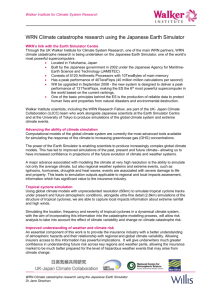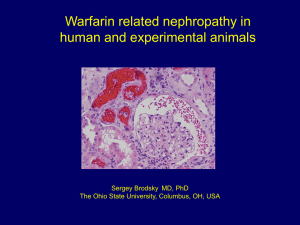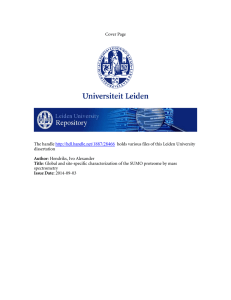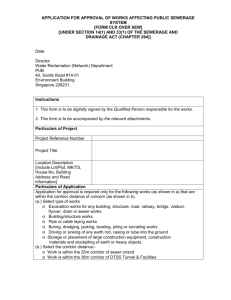Contents
advertisement
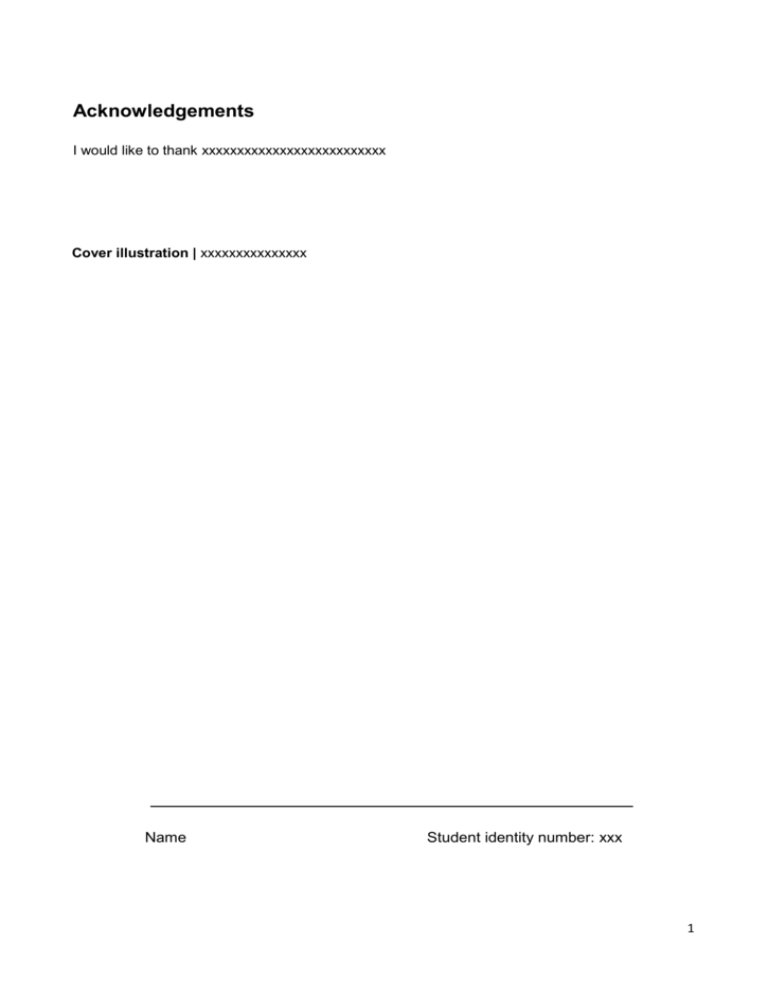
Acknowledgements I would like to thank xxxxxxxxxxxxxxxxxxxxxxxxxx Cover illustration | xxxxxxxxxxxxxxx Name Student identity number: xxx 1 Contents Abstract 4 Preface 5 1. Introduction 6 2. RecQ helicases 8 2.1. The RecQ helicase family 8 2.2. Human RecQ helicases 8 3. WRN 3.1. Werner syndrome 9 3.2. The WRN protein 11 4. The functions of WRN in DNA repair 14 4.1. DNA repair pathways 14 4.2. BER and SSBR 17 4.3. NER 19 4.4. MMR 21 4.5. DSBR 23 4.6. ICL repair 26 5. Other functions of WRN 33 5.1. Replication 33 5.2. Transcription and chromatin structure 34 5.3. Telomere maintenance 35 6. Post-translational modification of WRN 36 6.1. Phosphorylation of WRN 36 6.2. Acetylation of WRN 37 7. SUMOylation 37 7.1. Protein SUMOylation at a glance 37 7.2. The SUMO family of proteins 38 7.3. The SUMOylation pathway 39 7.4. Mechanisms of SUMO paralogue specificity 44 7.5. Consequences of SUMOylation 46 7.6. Interplay between SUMOylation and ubiquitination 48 7.7. SUMOylation and interplay with other post-translational modifications 50 7.8. SUMOylation of WRN 52 8. Materials and Methods 8.1. Buffers and solutions 2 9 54 54 8.2. Cells lines and cell culture conditions 54 8.3. Plasmid constructs 54 8.4. Primers and PCR 55 8.5. Enzymes and chemicals 56 8.6. Antibodies 56 8.7. Protocols 57 9. Results 61 9.1. Project overview 61 9.2. Subcloning of WRN 61 9.3. Generation of a quadruple potential SUMOylation site WRN mutant 63 9.4. Overexpression of SUMO-2 produces high-molecular weight WRN species 65 9.5. WRN is SUMO-2/3 conjugated in vivo and SUMOylation of WRN is induced by heat-shock 9.6. Cisplatin exposure induces SUMO-2 modification of WRN 67 70 9.7. Cells expressing SUMOylation-deficient WRN are impaired in the response to replication-associated DNA double strand breaks. 9.8. Cells expressing SUMOylation-deficient WRN are hypersensitive to cisplatin 73 76 10. Discussion and conclusion 78 11. Future perspectives 85 Abbreviations 89 References 90 Supplementary 102 S1. BLM and Bloom Syndrome 102 S2. RECQ4 and Rothmund-Thomson Syndrome 104 S3. RECQ1 106 S4. RECQ5 106 S5. BLM post-translational modifications 107 S6. SUMOylation of BLM 108 3 Abstract Werner Syndrome (WS) is a rare autosomal recessive disease characterized by ………………. 4 Preface Mutations in the genes encoding proteins involved in the maintenance of genomic integrity are the cause of several progeroid syndromes that This Master thesis can be seen as made up of two parts. The first part reviews the current understanding of the …………. The second part covers the experimental investigations that ….. Needless to say…… 5 1. Introduction As the process of senescence is complex, and may exist for a variety of different reasons, it can possibly derive from 6 2. RecQ helicases 2.1. The RecQ helicase family The helicase class of enzymes are ……………………….. 2.2. Human RecQ helicases Human cells possess five distinct ………………………… 3. WRN 3.1. Werner Syndrome WS is a rare autosomal recessive ……….. 3.2. The WRN protein WRN is a 1432 amino acid protein with a ………………… Oligomeric states of WRN The quaternary structure normally adopted by WRN ……… . Cellular localization of WRN WRN is a nuclear protein but the subnuclear localization ……. 4. The functions of WRN in DNA repair 4.1. DNA repair pathways DNA in cells is continuously exposed to ……….. 7 Figure 4 | DNA lesions and their repair by the four major DNA repair pathways in higher eukaryotes. Cells have multiple DNA repair pathways that provide …………… Figure 5 | Interaction of the RecQ helicases with DNA repair pathways. Evidence indicates that the RecQ helicases interacts with all the major DNA damage processing and repair pathways, including resolution of stalled replication forks. 4.2. BER and SSBR The BER process consists of ……….. 4.3. NER So far there has been little evidence for ……… 4.4. MMR The MMR pathway that removes base-base mismatches can be ………….. 4.5. DSBR The common, but toxic and mutagenic DNA DSB lesions are ………… Non-homologous end-joining (NHEJ) Both exonuclease and helicase …….. 4.6. ICL repair ICLs are very cyto- and genotoxic DNA lesions formed by ………. 8 Cisplatin Cisplatin (cis-platinum(II) diamminedichloride) ……….. Mitomycin C MMC is another commonly used crosslinking agent ………… Psoralen Psoralen requires exposure ……….. Model for mammalian ICL repair ICL repair in mammals is not yet well ……….. WRN and ICL repair There is considerable evidence ……… 5. Other functions of WRN 5.1. Replication During replication of the genome the DNA ………………………… 5.2. Transcription and chromatin structure 5.3. Telomere maintenance Telomeres are specialized nucleoprotein structures with ……… . 6. Post-translational modification of WRN 6.1. Phosphorylation of WRN Phosphorylation is one of the most common forms of ………. 6.2. Acetylation of WRN Acetylation of WRN by the transcriptional co-activator p300 in response to ……….. . 9 7. SUMOylation 7.1. Protein SUMOylation at a glance SUMOylation is a reversible post-translational modification that ….. 7.2. The SUMO family of proteins SUMO (Small Ubiquitin-related MOdifier) proteins are unusual …….. 7.3. The SUMOylation pathway The SUMOylation process results in .. SUMOylation (SUMO conjugation) Before the newly synthesized pro-SUMO proteins can ….. DeSUMOylation (SUMO deconjugation) As described, the SUMO pathway is … 7.4. Mechanisms of SUMO paralogue specificity Although some proteins are preferentially conjugated to one SUMO paralogue, many ……….. 7.5. Consequences of SUMOylation The functional effect and consequence of SUMO modification on a ….. SUMO-interacting motif (SIM) As mentioned, SUMO itself may contribute to ……. 7.6. Interplay between SUMOylation and ubiquitination While the post-translational ubiquitin modification performs ……… 10 Indirect co-regulation An antagonistic relationship is one possible mode of ………. Direct co-regulation SUMOylation and ubiquitination can directly affect ………… . 7.7. SUMOylation and interplay with other post-translational modifications Acetylation and SUMO Acetylation of lysine residues can regulate ………………. Phosphorylation and SUMO Phosphorylation of proteins is now understood to ……. 7.8. SUMOylation of WRN The first report that WRN was a target for ………… 8. Materials and Methods 8.1. Buffers and solutions BSA-PBST: PBST + 5 % w/v BSA HBS (2X): 274 mM NaCl, 10 mM KCl, 1.4 mM Na2HPO4, 12 mM glucose, 42 mM HEPES, adjust to pH 7.05 IP wash buffer: 50 mM Tris-HCl pH 7.5, 150 mM NaCl, 0.5% Igepal CA-630 …………………….. 8.2. Cells lines and cell culture conditions E. coli cells Prior to use all XL1-Blue and XL10-Gold E. coli cells ….. Human cells Prior to use, all human HEK293T …. 8.3. Plasmid constructs pBSCA-6XHis WRN expression vector (Figure 16) was generously provided ….. 11 8.4. Primers and PCR PCR A ~500 bp sequence of WRN cDNA was …. . Touchdown PCR Full-length WRN cDNA with ….. PCR Site-directed mutagenesis PCR site-directed mutagenesis amplification was performed on . DNA sequencing The fluorescence-based cycle sequencing reactions for use in the DNA sequencing were made with ……… 8.5. Enzymes and chemicals Enzymes Dpn I restriction enzyme ….. Chemicals Cisplatin (cis-Platinum(II) diamminedichloride, Sigma) ….. 8.6. Antibodies The primary antibodies used to detect WRN protein were ……… 8.7. Protocols Note that while … Agarose gel electrophoresis 1% agarose gels were cast with …………. Transformation of E. coli Heat-shock competent XL1-Blue E. coli or ………… Harvesting of plasmids from E. coli Bacterial colonies were cultured in ………….. Transient transfections Lipofectamine 2000-based transfection Culture dishes were seeded with ……… 12 Calcium Phosphate-based transfection Culture dishes were …………. . Preparation of whole cell extracts …………………. 9. Results 9.1. Project overview As previously described, WRN is involved in multiple ……… 9.2. Subcloning of WRN Numerous attempts were made to introduce …….. 9.3. Generation of a quadruple potential SUMOylation site WRN mutant WRN has 117 lysine residues and ………. 9.4. Overexpression of SUMO-2 produces high-molecular weight WRN species It has previously been shown that…….. 9.5. WRN is SUMO-2/3 conjugated in vivo and SUMOylation of WRN is induced by heat-shock One way to determine if the ……… 9.6. Cisplatin exposure induces SUMO-2 modification of WRN 13 WRN has been extensively studied and characterized …. 9.7. Cells expressing SUMOylation-deficient WRN are impaired in the response to replication-associated DNA double-strand breaks. WS cells are known to be …… 9.8. Cells expressing SUMOylation-deficient WRN are hypersensitive to cisplatin If SUMOylation of WRN is important for . Cisplatin HEK293T cells were ….. Camptothecin HEK293T cells were ……. 10. Discussion and conclusion WRN SUMOylation Given that WRN is known to be ….. Possible roles of WRN and WRN SUMOylation in ICL repair WS cells are hypersensitive to …. . Interstrand crosslinks in the premature aging phenotype of Werner Syndrome patients The hallmark of Werner Syndrome is premature aging……. SUMOylated WRN in the response to replication-dependent DSBs WS cells are hypersensitive to CPT……… Conclusion 14 In conclusion, WRN can be found ……… 11. Future perspectives Aspects of WRN SUMOylation Now that there is compelling evidence that WRN …… Stably transfected isogenic cell lines One very valuable approach would be the …. WRN at telomeres While there is little data on the effect of …… Final words The study of SUMO conjugated proteins is challenging and complex. The issue of ……… 15 Abbreviations 4-NQO, 4-nitroquinoline-1-oxide ……………………… 8-oxoA, 8-oxoadenine ……………………… 8-oxoG, 8-oxoguanine ……………………… ALT, alternative lengthening of telomeres ……………………… ……………………… ……………………… ……………………… ……………………… ……………………… ……………………… ……………………… ……………………… 16 WS, Werner syndrome References Ababou, M., Dutertre, S., Lecluse, Y., Onclercq, R., Chatton, B., Amor-Gueret, M., 2000. ATM-dependent phosphorylation and accumulation of endogenous BLM protein in response to ionizing radiation. Oncogene. 19, 5955-63. Agbor, T.A., Taylor, C.T., 2008. SUMO, hypoxia and the regulation of metabolism. Biochem Soc Trans. 36, 445-8. Ahn, B., Harrigan, J.A., Indig, F.E., Wilson, D.M., 3rd, Bohr, V.A., 2004. Regulation of WRN helicase activity in human base excision repair. J Biol Chem. 279, 53465-74. Ammazzalorso, F., Pirzio, L.M., Bignami, M., Franchitto, A., Pichierri, P., ATR and ATM differently regulate WRN to prevent DSBs at stalled replication forks and promote replication fork recovery. EMBO J. 17 Supplementary Contents S1. BLM and Bloom Syndrome S2. RECQ4 and Rothmund-Thomson Syndrome S3. RECQ1 S4. RECQ5 S5. BLM post-translational modifications S6. SUMOylation of BLM S1. BLM and Bloom Syndrome BS is a very rare autosomal recessive disorder with …….. S2. RECQ4 and Rothmund-Thomson Syndrome RTS is a rare autosomal recessive disorder characterized by ……. S3. RECQ1 No genetic disorders have so far been associated with ……. S4. RECQ5 RECQ5β is the largest of the three (α, β and γ) ……. S5. BLM post-translational modifications BLM is phosphorylated and accumulates in an …….. S6. SUMOylation of BLM A 2005 study identified BLM as a target for …… 18
